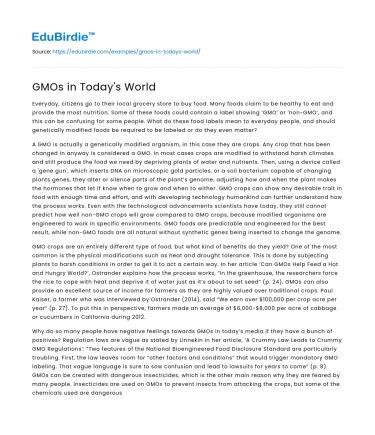Everyday, citizens go to their local grocery store to buy food. Many foods claim to be healthy to eat and provide the most nutrition. Some of these foods could contain a label showing ‘GMO’ or ‘non-GMO’, and this can be confusing for some people. What do these food labels mean to everyday people, and should genetically modified foods be required to be labeled or do they even matter?
A GMO is actually a genetically modified organism, in this case they are crops. Any crop that has been changed in anyway is considered a GMO. In most cases crops are modified to withstand harsh climates and still produce the food we need by depriving plants of water and nutrients. Then, using a device called a 'gene gun', which inserts DNA on microscopic gold particles, or a soil bacterium capable of changing plants genes, they alter or silence parts of the plant’s genome, adjusting how and when the plant makes the hormones that let it know when to grow and when to wither. GMO crops can show any desirable trait in food with enough time and effort, and with developing technology humankind can further understand how the process works. Even with the technological advancements scientists have today, they still cannot predict how well non-GMO crops will grow compared to GMO crops, because modified organisms are engineered to work in specific environments. GMO foods are predictable and engineered for the best result, while non-GMO foods are all natural without synthetic genes being inserted to change the genome.
Save your time!
We can take care of your essay
- Proper editing and formatting
- Free revision, title page, and bibliography
- Flexible prices and money-back guarantee
GMO crops are an entirely different type of food, but what kind of benefits do they yield? One of the most common is the physical modifications such as heat and drought tolerance. This is done by subjecting plants to harsh conditions in order to get it to act a certain way. In her article ‘Can GMOs Help Feed a Hot and Hungry World?’, Ostrander explains how the process works, “In the greenhouse, the researchers force the rice to cope with heat and deprive it of water just as it’s about to set seed” (p. 24). GMOs can also provide an excellent source of income for farmers as they are highly valued over traditional crops. Paul Kaiser, a farmer who was interviewed by Ostrander (2014), said “We earn over $100,000 per crop acre per year” (p. 27). To put this in perspective, farmers made an average of $6,000-$8,000 per acre of cabbage or cucumbers in California during 2012.
Why do so many people have negative feelings towards GMOs in today’s media if they have a bunch of positives? Regulation laws are vague as stated by Linnekin in her article, ‘A Crummy Law Leads to Crummy GMO Regulations’: “Two features of the National Bioengineered Food Disclosure Standard are particularly troubling. First, the law leaves room for “other factors and conditions” that would trigger mandatory GMO labeling. That vague language is sure to sow confusion and lead to lawsuits for years to come” (p. 8). GMOs can be created with dangerous insecticides, which is the other main reason why they are feared by many people. Insecticides are used on GMOs to prevent insects from attacking the crops, but some of the chemicals used are dangerous. One example includes the chemical used in the Vietnam War known as Agent Orange. McMillin states in ‘Trouble from Frankenfoods’, “The Veterans Administration (VA) regards Agent Orange exposure as associated with Parkinson’s disease, as well as numerous other conditions. These include diabetes, neuropathy, heart disease, liver dysfunction, chloracne, numerous cancers (e.g., leukemia, lung, prostate, and multiple myeloma) as well as birth defects (e.g., spina bifida) in the children of exposed soldiers” (p. 5). There are many bad things about GMOs, such as cross pollination and using chemicals known to be dangerous to treat crops. GMOs are safe to eat, but is their entire aspect also safe?
To finalize all thoughts, a GMO is any modification to an organism to change its genome, in this case the modification is to create bigger and stronger crops. Dangerous chemicals are used to treat the crops we eat, and poor regulations are put in place by our government to keep GMOs safe, but why is all of this information important? Take a look at the foods seen by people every day at the store and see how many people actually consume GMOs, the number could be quite surprising.






 Stuck on your essay?
Stuck on your essay?

